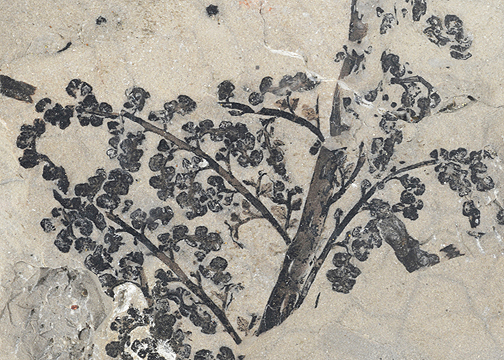Abstract
Plants and arthropods interact with each other and constitute an important part of the modern terrestrial ecosystem (Schoonhoven et al., 2005). Historically, fossil records of plant-arthropod interactions have been well documented in Paleozoic terrestrial ecosystems, which were evidenced by large coprolites containing various plant fragments (e.g., Salter et al., 2012), small larvae and coprolites remained in plant organs (e.g., Feng et al., 2017), and diverse functional feeding groups discovered on plant stems, rachises, roots, leaves and fertile organs (e.g., Liu et al., 2020).
References
Baxendale, R.W. (1979) Plant-bearing coprolites from North American Pennsylvanian coal balls. Palaeontology, 22, 537–548.
Chaloner, W.G., Scott, A.C. & Stephenson, J. (1991) Fossil evidence for plant–arthropod interactions in the Palaeozoic and Mesozoic. Philosophical Transactions of the Royal Society B: Biological Sciences, 333, 177–186. https://doi.org/10.1098/rstb.1991.0066
Chen, B.Y., Wan, M.L., Zhou, W.M., Wang, S.J. & Wang, J. (2021) Anatomy of Stigmaria asiatica Jongmans et Gothan from the Asselian (lowermost Permian) of Wuda Coalfield, Inner Mongolia, North China. Palaeoworld. https://doi.org/10.1016/j.palwor.2021.05.001
Feng, Z., Wang, J., Rößler, R., Ślipiński, A. & Labandeira, C.C. (2017) Late Permian wood-borings reveal an intricate network of ecological relationships. Nature Communication, 8, 556. https://doi.org/10.1038/s41467-017-00696-0
Feng, Z., Wang, J., Zhou, W.M., Wan, M.L. & Pšenička, J. (2021) Plant-insect interactions in the early Permian Wuda Tuff Flora, North China. Review of Palaeobotany and Palynology, 294, 104269. https://doi.org/10.1016/j.revpalbo.2020.104269
Labandeira, C.C. (1998) Early history of arthropod and vascular plant associations. Annual Review of Earth and Planetary Sciences, 26, 329–377. https://doi.org/10.1146/annurev.earth.26.1.329
Labandeira, C.C., Phillips, T.L. & Norton, R.A. (1997) Oribatid mites and the decomposition of plant tissues in Paleozoic coal-swamp forests. Palaios, 12 (4), 319–353. https://doi.org/10.2307/3515334
Lei, X.J., Zhou, W.M., Wan, M.L., Wei, H.B. & Wang B. (2020) A new scorpion from a Permian peat swamp in Inner Mongolia, China. Proceedings of the Geologists’ Association, 131, 160–167. https://doi.org/10.1016/j.pgeola.2020.02.006
Liu, H.Y., Wei, H.B., Chen, J.B., Guo, Y., Zhou, Y., Gou, X.D., Yang, S.L., Labandeira, C.C. & Feng, Z. (2020) A latitudinal gradient of plant-insect interactions during the late Permian in terrestrial ecosystems? New evidence from Southwest China. Global and Planetary Change, 192, 103248. https://doi.org/10.1016/j.gloplacha.2020.103248
Liu, L., Pšenička, J., Bek, J., Wan, M.L., Pfefferkorn, H.W. & Wang, J. (2021) A whole calamitacean plant Palaeostachya guanglongii from the Asselian (Permian) Taiyuan Formation in the Wuda Coalfield, Inner Mongolia, China. Review of Palaeobotany and Palynology, 294, 104245. https://doi.org/10.1016/j.revpalbo.2020.104245
Müller, A.H. (1982) Über Hyponome fossiler und rezenter Insekten, erster Beitrag. Freiberger Forschungsheft C, 366, 7–27.
Opluštil, S., Pšenička, J., Bek, J., Wang, J., Feng, Z., Libertín, M., Šimůnek, Z., Bureš, J. & Drábková, J. (2014) T0 peat-forming plant assemblage preserved in growth position by volcanic ash-fall: A case study from the Middle Pennsylvanian of the Czech Republic Bull. Bulletin of Geoscience, 89 (4), 773–818. https://doi.org/10.3140/bull.geosci.1499
Pšenička, J. & Opluštil, S. (2013) The epiphytic plants in the fossil record and its example from in situ tuff from Pennsylvanian of Radnice Basin (Czech Republic). Bulletin of Geosciences, 88 (2), 401–416. https://doi.org/10.3140/bull.geosci.1376
Pšenička, J., Wang, J., Zhou, W.M., Bek, J., Opluštil, S. & Votočková–Frojdová, J. (2020) A small heterophyllous vine climbing on Psaronius and Cordaites trees. International Journal of Plant Sciences, 181 (6), 616–645. https://doi.org/10.1086/708814
Shear, W.A. (1991) The early development of terrestrial ecosystems. Nature, 351, 283–289. https://doi.org/10.1038/351283a0
Slater, B.J., McLoughlin, S. & Hilton, J. (2012) Animal-plant interactions in a Middle Permian permineralised peat of the Bainmedart Coal Measures, Prince Charles Mountains, Antarctica. Palaeogeography, Palaeoclimatology, Palaeoecology, 363–364, 109–126. https://doi.org/10.1016/j.palaeo.2012.08.018
Schmitz, M.D., Shen, S.Z., Pfefferkorn, H.W. & Wang, J. (2021) A volcanic tuff preserving the Wuda Tuff Flora near the Carboniferous-Permian boundary in North China: Radiometric dating and stratigraphic position. Review of Palaeobotany and Palynology, 294, 104244. https://doi.org/10.1016/j.revpalbo.2020.104244
Schoonhoven, L.M., van Loon, J.J.A. & Dicke, M. (2005) Insect-plant biology (second edition). Oxford University Press, New York, 421 pp.
Scott, A.C. & Taylor, T.N. (1983) Plant/animal interactions during the Upper Carboniferous. Botanical Reviews, 49, 259–307. https://doi.org/10.1007/BF02861089
Wang, J., Pfefferkorn, H.W., Zhang, Y. & Feng, Z. (2012) Permian vegetational Pompeii from Inner Mongolia and its implications for landscape paleoecology and paleobiogeography of Cathaysia. Proceedings of the National Academy of Sciences, USA, 109 (13), 4927–4932. https://doi.org/10.1073/pnas.1115076109
Zhou, W.M., Li, D.D., Pšenička, J., Boyce, C.K. & Wang, J. (2019) A left-handed fern twiner in a Permian swamp forest. Current Biology, 29 (22), R1172–R1173. https://doi.org/10.1016/j.cub.2019.10.005
Zhou, W.M., D’Antonio, M.P., Boyce, C.K. & Wang, J. (2021) An upright psaroniaceous stump and two surrounding pecopteroids from the early Permian Wuda Tuff Flora. Palaeoworld, 30 (3), 451–460. https://doi.org/10.1016/j.palwor.2020.08.001


